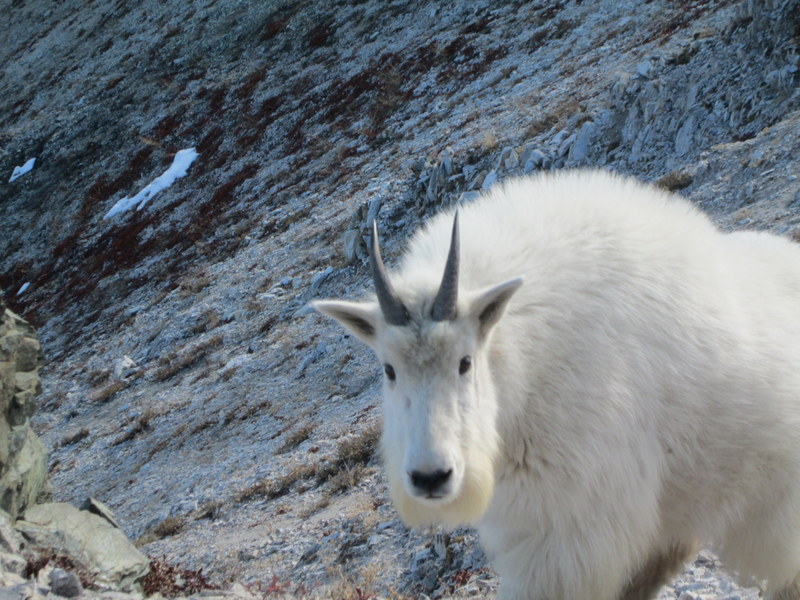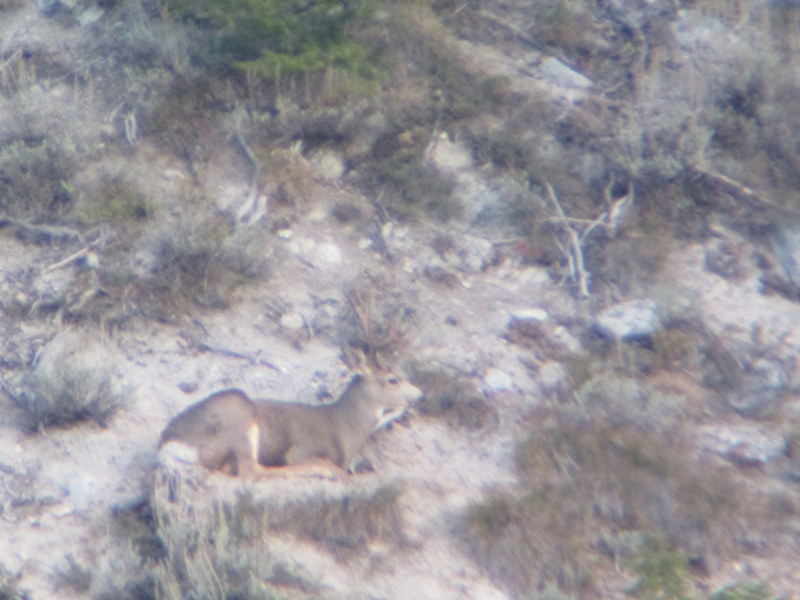About half way through the 2013 general deer season I made a trip out to hunt the Hell Hole for The Bucks I had seen while scouting. This was going to be a tricky hunt because I also planned on Elk hunting this area about two weeks later for the rifle Bull season and I didn’t want to spook Elk while Deer hunting. It had been a dry fall so far and the last significant snowfall had been at the end of September. The high country was mostly snow free and so I decided to try a different route and go into the upper end of the Hell Hole basin. I was thinking the Bucks would be all the way up this time of year with these weather conditions. I began hiking at about 9AM and the route I had chosen was not too difficult, after about 2 hours I was where I wanted to drop camp. I chose to take my bivy on this trip because I had planned on moving every day and covering a lot of ground along the main ridge if possible.
With camp set up, I scrambled up the scree slope to a knife edge ridge where I could see the upper end of the Hell Hole Basin. As always this was a lot more difficult than it looked on Google Earth. I found a tree and some shade that would allow me to peer over the top without sky lining myself and set up to glass for the afternoon.
It wasn’t long before I spotted a nice six point Bull Bedded at the far side of the basin. He was not a huge 300+ bull, but bigger than anything I had seen on the hoof in this unit yet. I did have a tag for this unit but the hunt didn’t start for another twelve days. This immediately ruined the Deer hunt, as now I was focused on Elk. This is about how it goes each season for me in Idaho. I spend the majority of my time scouting and hunting for mature deer and end up finding nice Elk. This Bull was bedded in a good stockable location and had the season been open it would have been a slam dunk. A short scramble around the ridge I was on would have put me about two hundred yards above him and to his left. I played that scenario out in my head for a week after that trip!
It was later in October and this Bull was bedded off by himself indicating he might have been the herd Bull. I still question this though because he was not as big as the shed I found during my spring scouting trip in that area. There just may be a huge Bull that swoops in and breeds that herd and then disappears for the season.
After getting some pics and video, I continued to scan the basin and found the rest of the herd scattered around and closer to my glassing position. There were 3 other decent Bulls, some spikes, and some cows and calves. There was a dirty five point next to a spike amongst the cows and calves.
As I was watching the dirty five point, I heard antlers clanking and saw two nice five point Bulls sparing.
While I was intently focused on the Elk, I heard footsteps on the ridge to my left. When I finally turned my head to look, I caught a glimpse of a goat heading my way. I slowly turned and got my camera ready when he wasn’t looking. He walked right up to me and I snapped a pic, the sound spooked him and he busted along the ridge in the direction he was headed. This happens to me about once a year, I tend to end up glassing from way up high on a steep ridge, sometimes looking down on Goats.
I was really hoping the Elk were used to seeing this goat and didn’t get spooked as I watched him effortlessly move across the roughest terrain in the lower 48.
Fortunately they didn’t get spooked and I was able to continue watching them. The two five points stopped sparing and the dirty five point headed over towards them. It wasn’t long before the the dirty five point and the next smallest five point began sparing. This time it was out in the open and I was able to get a good sparring video of it.
All this sparring action seemed to have got the attention of the six point that was off bedded by himself. He got up and fed his way over to the herd.
I was able to get some video and a better look at him as he walked over to the herd. He didn’t look like he would hit 300, but for an OTC public land Idaho Bull he was a trophy. If the weather would hold up for the next 12 days, the Elk would likely be in this same spot and I would have a good chance at this Bull. I watched the Elk for a little while longer and then pulled back off the ridge a little so I could continue to traverse it without being detected. It was getting later in the afternoon now and I wanted to glass over some new country.
After a short hike along the ridge I made it to the top of a peak where 3 main ridges came to together. There were some tracks in the snow that looked like human, however the route they had taken to get to the peak was such that they would have never seen the Basin the Elk were in. The snow was deep up on the very top and the sunny warm weather made it slushy and difficult. I moved off the peak and along the main ridge for about a half mile glassing over the country and watching for tracks. My head wasn’t really in the Deer hunt game at this point. I didn’t want to risk spooking the Elk so I headed back to camp after a short evening glassing session. My plan was to hike out the next morning and come in from below to glass the slope where I had seen Deer while scouting in the spring.
The next morning I packed up camp and climbed up on the ridge to see if the Elk were still there. The sun was at my back so I opted to not setup and glass. I peered over a rock pile and saw a couple Elk through my binoculars, heard a bugle, and was satisfied. I dropped back down a little and still hunted my way back to the truck. This made the hike out a little longer and by the time I drove around to the access point that gets me in from the bottom it was almost dark. I slept in the back of the truck instead of hiking in that night. I carry a spare sleep system that I leave in the truck just for this purpose. This way I can eliminate packing and unpacking my backpack.
I figured it would take 2 hours to get into a good glassing position the next morning and got an early start on the hike in. I got into position at first lite and spotted a little fork horn and a cow Elk. This basin was both full of Elk and surrounded by Elk. The cow was at the top of the mountain and fed her way over the top pretty fast as it got light. The forky bedded about the same time on a southeast exposure. I didn’t see the bigger Bucks, it seemed that the Elk had taken over the area they were in. This is not uncommon, I see this scenario pretty consistently. Mature Bucks don’t like the noise and activity that a herd of Elk brings.
I decided that my Deer season was over for the year and it was time to fully concentrate on next weeks Elk hunt. I decided to use the rest of the day to get familiar with the trail that goes in and out of the basin for the anticipated Elk harvest. I hiked up the lower end of the ridge adjacent to the basin to the rendezvous point. This is about half way up the mountain where 3 main trails converge including the one that was coming up from the bottom I was on. From there I decided not to go into the basin and risk spooking the Elk. All it would take is one little group of Elk running scared through the basin to ruin the hunting for next weeks season opener. I instead hiked the other way on the trail where I had originally seen the Bucks from for a short distance. They were not there but I did see a nice fresh scrape from one of the Bulls.
It was time to sneak out of there before I got busted by an Elk. I did a mock up meat pack out as I hiked out. I identified the trees where I would hang the meat and prepared them for it. This was going to be an epic pack out over rough steep terrain for 1.5 miles and then 4.5 miles of trail. I figured it would take probably 2 days and this would need to be factored into the hunt.
The weather for the next 10 days would dictate whether I go in high again or go in from below. If it snows enough the Elk will probably get pushed down and going in from below would be the thing to do. Going in high would give me the height advantage and the distance is less, however I would have to pack meat uphill and through a little bit of Goat country. I pondered this the whole hike out and all the way home!














